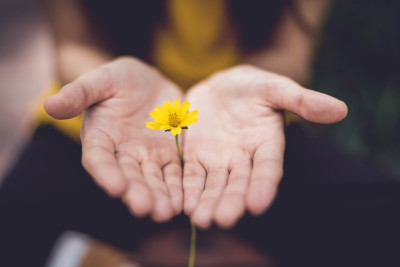Holding Space: The Yoga Teacher's Role

Much of my work as a yoga teacher involves the act of holding space. One would think that a yoga teacher would spend more time creating sequences, studying up on poses, or other tangibles like that. The way I see it, the bedrock of a yoga class is how well the teacher can hold space for the students. Without that, you have a group fitness class---nothing wrong with that---but not a yoga class. What does "holding space" mean, though?
Coming to a yoga class is different from an exercise class. Yoga means union. The path of yoga is to unify---sun and moon, dark and light, masculine and feminine, body and breath, mind and body, to integrate and assimilate the disparate parts of ourselves. It is a continual process. How do you even teach such a thing? Not in the usual way that something is taught--linear, hierarchical, information based. Mostly, you don't teach it as much as be it, communicate, or transmit it. You facilitate it.
This is the tricky part of teaching yoga classes. Presence is key. A teacher has to be 100% present in a grounded and centered way. This is what we as teachers are aiming for. Much of this work is done by the teacher off the mat. For me, this preparation involves whatever it takes to feel that union with my Source---I try to spend as much time there as possible. Whether that is walking in nature, making art, being with my family or animals, doing asana, tai chi, Aikido, meditating, praying... That way when I show up for class to teach, I'm prepared as much as I can be to hold the space.
Why do people come to a yoga class vs. a gym or instead of just doing yoga on You Tube? They are looking for someone to hold a space for them to engage in this process of practicing this state of union amidst the contrast of life. The one hour class is a structured container for this process to occur. Every part of the class. Every word spoken, action taken, and even casual interaction, is to help the student reach this goal.
While much of holding space is about that intangible "presence" that the teacher needs to cultivate in herself, there are also other more tangible parts. Here are some: The use of language and voice. Speaking in a somewhat slower and more soothing tone of voice than our casual voices helps the students' thoughts to slow down. Leaving lots of silent spaces. Making sure that when we do talk, it is for a reason, not just to fill space. Doing our best to either cushion the sounds and distractions from the external world, or when unavoidable, helping the student to practice with it. Using words that connote positive things to elevate the students minds. I'll say "root into the earth" rather than "plant your feet on the mat" for example. "Float your arms down to your sides" rather than "bring your arms down" etc. Guiding the students minds inward to the internal space, and gently away from the cares of the world. Helping the students to detach from the craving for visual and auditory stimuli through closing the eyes and creating an inner focus. This can also be done by guiding the students to feel what is going on inside of the body---from the obvious to the subtle. From the large obvious movements, to the micro movements, to the very subtle flow of energy. From the gross to the subtle layers of being. And most importantly, reminding the students to breathe.
And finally, there is asana. The choice of the poses---which poses to focus on and which to leave out. I prefer grounding poses done in a slow and fluid way. I do provide challenge to students, but this isn't my focus. I learned that growing in yoga comes through reducing intensity with more experience in the practice. Reducing the intensity allows you to relax and better perceive how to guide your practice to produce a genuine sense of peace.
Different teachers have different styles, but I believe at the core of it all is the very important act of working on ourselves primarily. Of living the union we are teaching. And from that centered and grounded place, holding the space for students to work on the same.
